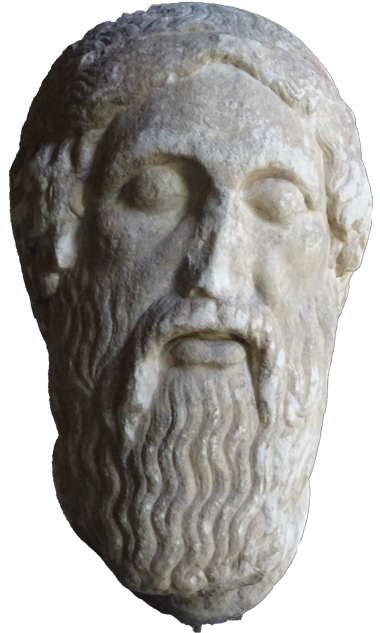Eumaios’ pigfarm
Odysseus Unbound places Eumaios’ pigfarm south of Atheras at the foot of Mt Lachties.
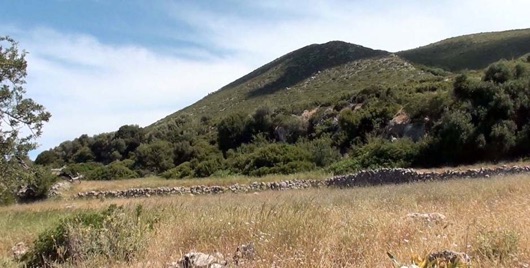
the old farm at the foot of Mt Lachties looking north-east
The farm is high up
The first thing we can be sure of from Homer about Eumaios’ farm is that it is high up. To get to it, as we read at the opening of Book 14, Odysseus had to climb up from the harbour through woodland and hill-tops [ἄκριας] (14.2). Homer employs the word ἄκριας elsewhere to describe the “windy heights” where the Cyclops lived (9.400), and the “windy heights” where the suitors kept their lookout for Telemachus (16.365). Odysseus “climbed” [προσέβη] from the harbour as he did on a hunting expedition with the sons of Autolycus: they “climbed” [προσέβαν] “up the steep mountain, Parnassus, clothed with forests” (19.431). To get to the farm, moreover, Odysseus went along a rough or rocky [τρηχεῖαν] path (14.1), a word often associated with “rugged Ithaca” (9.27, 10.417, 10.463, 13.242), and once used to describe Odysseus being swept against a “rugged shore” that was all rocks and cliffs (5.425).
Does this match the old farm? The walk from Atheras Bay is up a gentle slope which may once have been wooded but is not now particularly rocky. The path comes to the town of Atheras, which sits beneath Mt Lachties, almost in a saddle or a pass. It is high and there appear to be good water sources. Then there is a gentle walk downhill to the farm, which also lies beneath Mt Lachties and extends almost to the rocky outcrop identified as “Raven’s Rock.” There are no hill-tops or mountain peaks on the way.
The opening shot of my video A walk up Mt Lachties from the slopes of the mountain shows Atheras Bay, the route up to Atheras, the village itself, and the area just south of the village where the old farm is located over the crest of the mountain slope.
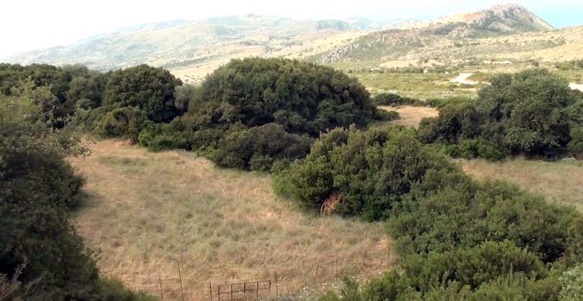
the northern end of the old farm beneath Atheras, looking south
The fact that the farm must be high up is even clearer when we consider the path down into the city. Odysseus, disguised as a beggar and disguising his knowledge of the nature of the path, says to Eumaios: “truly you said the way was treacherous [ἀρισφαλέ᾽]” (17.196). The word ἀρισφαλέ᾽ also means “very slippery,” implying that the path is steep and rocky, and possibly wet. Furthermore, the path they “followed down [κατά]” is described as “rugged [παιπαλόεσσαν].” This word crops up elsewhere when Odysseus seeks information on how to get home to “rugged Ithaca” (11.480). It is also used to describe the strait “between Ithaca and rugged Samos” (4.671, 4.845, 15.29). Odysseus also tells of how he “climbed to a rugged height” in the land of the Laestrygonians (10.97) and on the island of Aeaea (10.148). In summary, the path from the farm down to the city is steep, rocky and dangerous.
Yet the path – or rather the route – from the old farm to Kasteli is quite level. It hardly descends at all, and in the final stage it ascends.
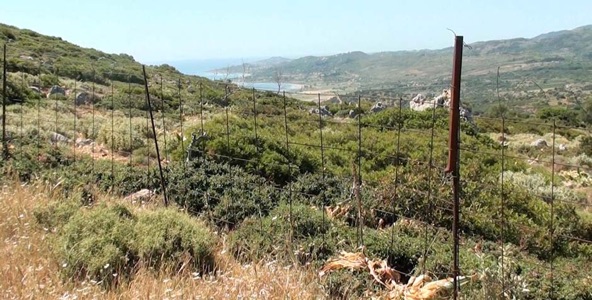
the southern end of the old farm with a glimpse of Argostoli Bay
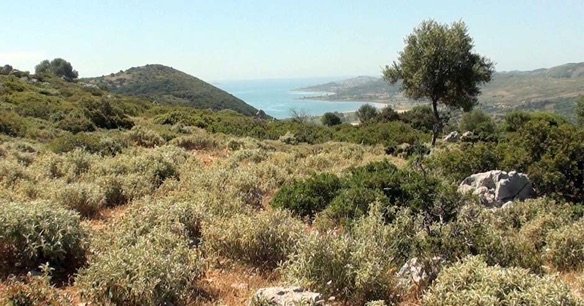
100 metres south of the old farm with a view of Kasteli and Argostoli Bay
The farm has a wide view
Another aspect of height is the view. Eumaios’ house had in front of it a “court built high in a place with a wide view… with an open space around it” (14.5ff). That is, it not only had a view [περισκέπτῳ], it could also be seen from afar, like Telemachus’ bedroom “high, in a place with a surrounding view” (1.426), and Circe’s house “in a place of wide outlook” (10.211, 253).
The old farm is nestled on the side of Mt Lachties. From one aspect, on the hill above the farm, there is a view south and west. But the dominating height of Mt Lachties prevents any surrounding view, either from the farm or of it.
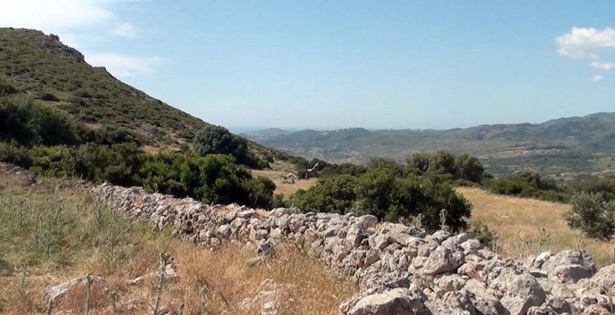
view south from the middle of the old farm with “Raven’s Rock” on the left
The farm is far from the city
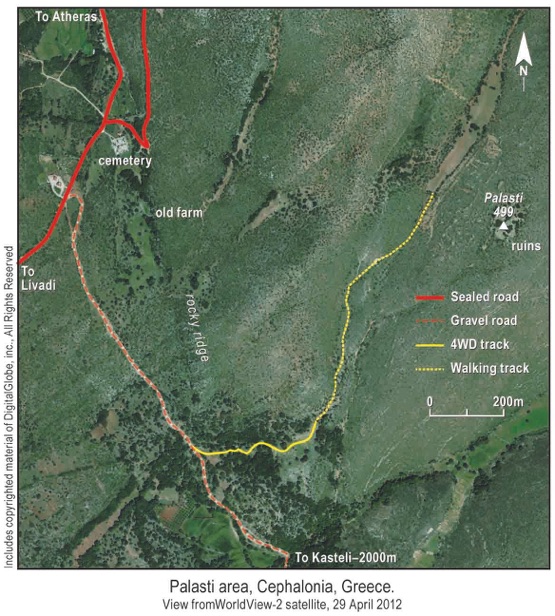
It is about an hour’s walk from the old farm to Kasteli, and 45 minutes to Palasti.
At the beginning of Book 17, Telemachus makes haste to go from Eumaios’ house to the city in order to show his mother he is back home in Ithaca. Odysseus, still disguised as a beggar and perhaps again disguising what he knows of the path to the city, says to Telemachus and Eumaios: “you say it is far [ἕκαθεν] to the city” (17.25). Homer does not record that they said this. However, assuming they did, or that Odysseus believes it is far, how far is it?
Without a point of comparison, of course, it is impossible to be certain. In some cases in the Odyssey one can get a good sense of a distance, for example: Achilles “died at Troy, far [ἑκάς] from Argos” (24.37), or when Athene advised Telemachus: “you do not do well to wander longer far [ἀπό] from your home” (15.11) – they were in the palace of Menelaus, a long way from Ithaca. In other cases, one can get a fair idea of a distance: “as far [ἀπὸ] from the city as a man’s voice carries when he shouts” (6.294). In yet other cases it can seem as if “far” is not far at all. Laertes’ farm is described as “far [νόσφι] from the city” (24.212), yet Odysseus and his men are able to get there “quickly” after they have slaughtered the suitors. Eumaios does not like to sleep in his hut “far” [ἄπο] from his boars, so he sleeps amongst them (14.525). In the case of Eumaios’ farm, there is no guidance like these examples on its distance from the city.
But can we realistically believe that the strong men in Eumaios’ hut considered an hour’s walk down a path as “far” in any sense of the word?
I walked along the route with ease in 2013. I am probably older than Eumaios and certainly less fit, and I needed no stick to help me. It wasn’t far or treacherous at all.
In response to criticism that the pigfarm in Odysseus Unbound was not far from the city or Odysseus’ palace, Robert Bittlestone addressed the question “How Far was Eumaios' Pigfarm from Odysseus' Palace?” in the Revue des études anciennes, Vol. 110, No. 2 (2008), 569-572. He argued that Homer’s language supported the idea that the pigfarm was “some distance away” but not “far away” from the palace; “the pigfarm surely cannot have been more than about an hour’s walk from the palace. I find it very hard to see how, for example, this fits in with the 30-mile round trip favoured by J.V. Luce (Celebrating Homer’s landscapes: Troy and Ithaca revisited, Yale, 1998, p. 218 and map p. 177).”
In considering distance and how far it might be, we should be careful not to do so as armchair travellers or occasional ramblers. Some people, like rural Africans for example, walk enormous distances, day and night, often bearing heavy loads.
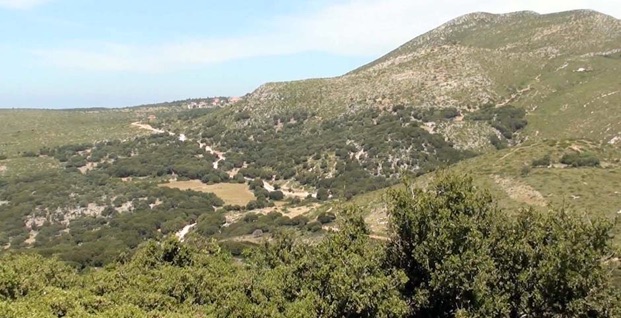
The view north from the summit of Kasteli. The old farm is located just south of Atheras in the distance and behind the ridge “Raven’s Rock” at the foot of Mt Lachties.
The farm is on the edge of the island
One thing that is certain is that Eumaios dwelt at the far end of the island. We have it from the ghost of the suitor Amphimedon as he bemoans his fate: “then it was that some evil god brought Odysseus from somewhere to the border of the land [ἐσχατιήν], where the swineherd dwelt” (24.150). Homer uses this word to express outer limits, as in “the storm wind … bore him … to the end of the land” (4.517), “I then climbed the headland to get a view from the top” (10.96) (Rieu), “on the land’s edge close by the sea” (9.182), “a remote part of the land” (9.280), “an outlying farm” (5.489, 18.358).
Eumaios himself uses the word when he describes the extent of Odysseus’ flocks on the mainland and on Ithaca: “And here too graze wide-ranging herds of goats on the borders of the island [ἐσχατιήν], eleven in all, and over them trusty men keep watch. And each man of these continually drives up day by day one of his flock for the suitors…” (14.103-105). That is, it is possible to go from the extremities of the island to Odysseus’ house in one day.
The old farm near Atheras is not on the border of the land. It lies in the middle of the northern part of the Paliki peninsula. The closest sea is Atheras Bay more than 3 kilometres away to the north. Beyond it lie Cape Atheras and Cape Katergaki.
Perhaps Eumaios’ farm was somewhere else?
